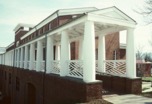loaded - In painting, a loaded brush is one that is charged or filled with paint to its capacity.
Also see impasto.
loan - Museums and patrons often work closely together to lend objects to each other to improve the range of works in the collections they exhibit.
local color - The true color of an object or a surface as seen in typical daylight, rather than its color as seen through atmosphere or interpreted by the taste or imagination of the artist. Thus the characteristic local color of a lemon is yellow.
Related link:
Also see aerial perspective and reflected color.
loggia - In architecture, a gallery that has an open arcade or a colonnade on one or both sides.
(pr. LAW-jee-ə, LAH-jee-ə)
Examples:

![]()

Filippo Brunelleschi (Italian, 1377-1446),
Foundling Hospital (Ospedale degli Innocenti),
1419-26, Piazza SS. Annunziata, Florence. See Renaissance.

Andrea Palladio (Andrea di Pietro della Gondola)
(Italian, 1508-1580), The Rotonda's loggia, 1550, Vicenza, Italy. A few people
stand on the loggia, looking toward Vicenza's Piazza dei Signori.
![]()
![]()
![]()
Italy, Palazzo Rosso's loggia, 17th century, Genoa.
See Baroque.

![]()

Michael Graves (American, 1934-), Bryan Hall, 1995, U of Virginia, Charlottesville,
VA. Historicism is evident in Michael Graves' design
of this postmodern loggia.
Also see portico.
longtitudinal stage - Of Victor Lowenfeld's Stages of Artistic Development, the longtitudinal stage is the second sub-stage of the first stage, the scribble stage. The Scribble stage typically occurs at 2-4 years old. The Longitudinal stage is characterized by controlled repetitions of motions. A child at this stage of development demonstrates visually an awareness and enjoyment of kinesthetic movements. Also see preschematic stage (4-6), schematic stage (6-9), dawning realism stage (9-11), and the pseudorealistic stage (11-13).
Related link:
Also see length.
lookism - Prejudice or discrimination on the grounds of
appearance. Thinking less
of a person whose appearance is less than ideal
(too far below fashion
model), or thinking
more of a person because his / her appearance is ideal enough.
Such factors of appearance may include the shape,
color, texture
or expression of facial or
bodily features, hairstyle, costume,
or body language. A person who practises lookism is a lookist.
 The earliest citation of lookism's appearance in print is in the
Washington Post Magazine in 1978, which reported that fat
people had coined it as a defensive word: "lookism — discrimination based on looks." It's coinage has followed
those of the words racialism / racism (1907 / 1935), sexism (1968),
and ageism (1969).
The earliest citation of lookism's appearance in print is in the
Washington Post Magazine in 1978, which reported that fat
people had coined it as a defensive word: "lookism — discrimination based on looks." It's coinage has followed
those of the words racialism / racism (1907 / 1935), sexism (1968),
and ageism (1969).
Also see ethnocentrism, feminism and feminist art, gender issues, humanism, idealized, isms and -ism, multiculturalism, political correctness, stereotype, ugly, xenophilia, and xenophobia.
loom - An apparatus for producing textiles, rugs, blankets, wall hangings, etc., by weaving thread or yarn into cloth.
Also see fabric and fiber.
 loop
tool - A tool consisting
of a loop of nonferrous
metal attached to a handle,
and used in carving plastic
and leather-hard clay. The metal loop might either be round in cross-section (like ordinary wire) or more like a ribbon. A loop tool can easily
be improvised with a piece of wire.
Even a paperclip can serve well.
loop
tool - A tool consisting
of a loop of nonferrous
metal attached to a handle,
and used in carving plastic
and leather-hard clay. The metal loop might either be round in cross-section (like ordinary wire) or more like a ribbon. A loop tool can easily
be improvised with a piece of wire.
Even a paperclip can serve well.
Also see ceramics, ferrule, modeling tools, and subtraction.
lorem ipsum - The first two words of a string of Latin words used as placeholder or dummy text in graphic design layout proposals. Placing this filler text is incongruously known as "greeking." It is quoted fully below.
Bill Pugh of New Zealand informed us in July 2001 that much of lorem ipsum comes from Cicero's de Finibus Bonorum et Malorum, a treatise on the theory of ethics written in 45 BCE:
"Neque porro quisquam est qui dolorem
ipsum quia dolor sit amet, consectetur, adipisci velit..."
There is no one who loves pain itself, who seeks after it and
wants to have
it, simply because it is pain...
Much of the entire passage is pseudo-Latin, because although it contains lots of Latin words, they are largely incoherent, and some are utter nonsense — there's no Latin word lorem, for one thing. But its "words" loosely approximate the frequency with which letters occur in English, which is why at a glance it looks like reasonable text.
One source claims this text has been the industry's standard dummy text ever since a printer in the 1500s took a galley of type and scrambled it to make a type specimen book. If this is true, lorem ipsum has survived not only four centuries of letter-by-letter resetting but even the leap into electronic typesetting, essentially unchanged.
This text was available for many years on adhesive sheets in various sizes and typefaces as dry transfer graphics. In pre-desktop-publishing days, a designer would cut pieces out with an X-acto knife and stick them on their pages to simulate the look of the final version. When computers came along, some desktop publishing software included it among their tools, so now you see it wherever designers are at work, including all over the Web.
Here are some blocks of it:
Lorem ipsum dolor sit amet, consectetuer adipisci velit, sed diem nonummy nibh euismod tincidunt ut lacreet dolore magna aliguam erat volutpat. Ut wisis enim ad minim veniam, quis nostrud exerci tution ullamcorper suscipit lobortis nisl ut aliquip ex ea commodo consequat. Duis te feugifacilisi. Duis autem dolor in hendrerit in vulputate velit esse molestie consequat, vel illum dolore eu feugiat nulla facilisis at vero eros et accumsan et iusto odio dignissim qui blandit praesent luptatum zril delenit au gue duis dolore te feugat nulla facilisi.
Ut wisi enim ad minim veniam, quis nostrud exerci taion ullamcorper suscipit lobortis nisl ut aliquip ex en commodo consequat. Duis te feugifacilisi per suscipit lobortis nisl ut aliquip ex en commodo consequat. Lorem ipsum dolor sit amet, consectetuer adipiscing elit, sed diem nonummy nibh euismod tincidunt ut lacreet dolore magna aliguam erat volutpat. Ut wisis enim ad minim veniam, quis nostrud exerci tution ullamcorper suscipit lobortis nisl ut aliquip ex ea commodo consequat. Duis te feugifacilisi. Duis autem dolor in hendrerit in vulputate velit esse molestie consequat, vel illum dolore eu feugiat nulla facilisis at vero eros et accumsan et iusto odio dignissim qui blandit praesent luptatum zzril delenit au gue duis dolore te feugat nulla facilisi. Ut wisi enim ad minim veniam, quis nostrud exerci taion ullamcorper suscipit lobortis nisl ut aliquip ex en commodo consequat. Duis te feugifacilisi per suscipit lobortis nisl ut aliquip ex en commodo consequat.
Duis te feugifacilisi. Duis autem dolor in hendrerit in vulputate velit esse molestie consequat, vel illum dolore eu feugiat nulla facilisis at vero eros et accumsan et iusto odio dignissim qui blandit praesent luptatum zzril delenit au gue duis dolore te feugat nulla facilisi. Ut wisi enim ad minim veniam, quis nostrud exerci taion ullamcorper suscipit lobortis nisl ut aliquip ex en commodo consequat. Duis te feugifacilisi per suscipit lobortis nisl ut aliquip ex en commodo consequat.
lossless compression - A process that reduces the storage space needed for an image file without loss of data. If a digital image that has undergone lossless compression is decompressed, it will be identical to the digital image before it was compressed. Document images (i.e. in black and white, with a great deal of white space) undergoing lossless compression can often be reduced to one-tenth their original size; continuous tone images under lossless compression can seldom be reduced to one-half or one-third of their original size.
Also see lossy compression.
lossy compression - A process that reduces the storage space needed for an image file. If a digital image that has undergone lossy compression is decompressed, it will differ from the image before it was compressed (though this difference may be difficult for the human eye to detect). The most effective lossy compression algorithms work by discarding information that is not easily perceptible to the human eye.
Also see lossless compression.
lost-wax casting - A casting process for which a sculptor must first produce his sculpture in wax. He creates a mold around this made of refractory materials. When the mold is heated, the wax melts away, so that molten metal can replace it, reproducing exactly the original wax sculpture. Also known by the French term cire-perdue (pr. SEER-payr-DOO).
Also see core, direct casting, indirect casting, investment, rodding, sincere, sprue, and articles about the various metals.
lotiform - In the form of a lotus petal. See Buddhism.
love - Strong affection or compassion for another arising out of familial or personal bonds, or an affection based on admiration, benevolence, or common interests; or based on romantic or sexual desire. An enthusiasm, devotion, or desire. Or the object of devotion, admiration, or attraction. Or unselfish loyal and benevolent concern for the good of another. Or sexual intercourse; copulation.
Quotations:

Also see allegory, attitude, beauty, expression and expressionism, Expressionism, fame, feminism and feminist art, gemütlichkeit, gender issues, fig leaf, Madonna, motivation, mythology, nude, obscenity, pain, pornography, posterity, praise, quality, quotations, Romanticism, sensuality, sublime, and success.
low art - Refers to the lesser or minor arts, including the decorative or applied arts, with the inference that these are low partly because of shoddy manufacturing in inferior materials of superficial kitsch, simply catering to popular taste, unreflective acceptance of realism, and a certain "couch potato" mentality. The boundary between high and low art has faded in the contemporary art scene. Its place has been taken by discussion of popular or mass culture.
Also see bad art, brummagem, buckeye, gewgaw, high art, paint-by-number, and realia.

lowercase - To write faster than they could when writing
only capital letters
(uppercase), sixth-century scribes
simplified capital letter forms and
developed "miniscule" letters. This was the origin of
lowercase letters, which now comprise most of our typographic
communications.  They got the
name lowercase from the standard location in which typesetters
stored these letters — in large thin drawers known as cases,
the lower ones rather than the upper ones. The lowercase letters shown here are more contemporary designs.
They got the
name lowercase from the standard location in which typesetters
stored these letters — in large thin drawers known as cases,
the lower ones rather than the upper ones. The lowercase letters shown here are more contemporary designs.
low relief - In relief sculpture, a very slight extension of a form out of the background.
![]()
![]()
![]()
lozenge - A four-sided two-dimensional figure with a diamondlike shape; a rhombus that is not a square. Also, a thing having this shape.
(pr. lah'zenzh)
Lucite® - A trademark for a plastic material, which is a family of acrylics in the smaller group called a methacrylates, available in many forms, including liquid for casting. It can be made highly transparent, translucent, or opaque. Visit luciteinternational.com for much more information.
Also see cellocut, fiberglass, PlexiGlas®, polyester resins, and resins.
Luminism or luminism and luminists
luminosity - A quality seen in some paintings of a glow coming from within, the illusion that there is actually a light coming out of the picture. Glossy colors are more likely to provide this luminous effect than matte colors.
Examples:
Georges de La Tour (French, 1593-1652), Christ with St. Joseph in the Carpenter's Shop, c. 1640, oil on canvas, 1.37 x 1.02 m, Louvre. See Baroque and Caravaggisti.

Sanford Robinson Gifford (American, 1823-1880),
Kauterskill Clove, 1862, oil
on canvas, 48 x 39 7/8 inches
(121.9 x 101.3 cm), Metropolitan Museum of Art, NY. This painting
is typical of the works produced in the art
movement called Luminism.

William Trost Richards (American, 1833-1905),
Moonlight on Mount Lafayette, New Hampshire,
1873, watercolor,
gouache, and graphite on gray-green wove
paper, 8 1/2 x 14 3/16 inches (21.6 x 36 cm), Metropolitan
Museum of Art, NY. See luminosity.

A talisman of unidentified origin and meaning,
probably contemporary, apparently
gold, translucent
red and blue gems, and bone
or horn fragments.
This image shows it emanating a mysterious luminosity.
This jewel is analogous
to purportedly powerful objects in Hollywood's pseudo-archaeological adventure stories, like the mummy and Indiana Jones movies. See
talisman.
Also see brilliance, candela, Caravaggisti, Impressionism, nocturne, optical mixing, tenebroso or tenebrism, and value.
luminous - See candela, color, light, luminosity, and value.
luminous paint - A paint
which actually glows in the dark. It contains a phosphor, which
is usually a form of zinc
or calcium sulfide. It stores light
when exposed to it for a length of time,
emitting it as a greenish or bluish glow for a relatively short
length of time when the light source
is removed. Versions of luminous paints with radioactive ingredients are used in situations
in which the duration of glow must be prolonged, as on watch faces,
but these paints are considerably more hazardous,
and less commonly available.
Also see fluorescence, fluorescent colors, fugitive colors, glitter, opalescence, and pigment.
![]()
![]() lump hammer - A hammer with a heavy, rectangular
head, usually made of iron,
used to strike stone cutting
tools.
lump hammer - A hammer with a heavy, rectangular
head, usually made of iron,
used to strike stone cutting
tools.
Also see ballpein hammer, bush hammer, chisel, claw hammer, and mallet.
![]()

lunette - In architecture, a semicircular (fan-shaped) opening (with the flat side down) in a wall or a door. The word comes from the French for half-moon. Also, "lunette" can refer to a semicircular painting set separately within a work's frame, as in the design of a fan.
(pr. loo-NET)
Examples of the second sense:

Bartolomeo di Giovanni (Italian, Florentine,
active by 1488, died 1501), The Trinity, lunette, tempera
on wood panel;
painted surface 5 1/8 x 10 1/4 inches (13 x 26 cm), Metropolitan
Museum of Art, NY. Bartolomeo di Giovanni collaborated
with Sandro Botticelli (Alessandro di Mariano Filipepi) (Italian,
Florentine, 1444/45-1510) on at least one occasion. This lunette
was placed within the same frame
as, and over a painting by Botticelli, The Last Communion of Saint Jerome, dating
from the early 1490s. See Renaissance.

Michelangelo Buonarroti (Italian, 1475-1564),
Jacob
and Joseph, 1505, fresco,
a detail of the ceiling of the Sistine Chapel, Vatican.

Raphael (Raffaello Sanzio or Santi) (Italian,
Marchigian, 1483-1520), Madonna and Child Enthroned with Saints,
altarpiece, c. 1504, tempera and
gold on wood;
main panel, overall 67 7/8 x 67 7/8
inches (172.4 x 172.4 cm), painted surface 66 3/4 x 66 1/2 inches
(169.5 x 168.9 cm); lunette, overall 29 1/2 x 70 7/8 inches (74.9
x 180 cm), painted surface 25 1/2 x 67 1/2 inches (64.8 x 171.5
cm), Metropolitan Museum of Art, NY. (On the Met's page, you
can enlarge any detail.) See Madonna.

Louis Sullivan (American, 1856-1924), Northwestern
Terra Cotta Works, Norweta, Lunette, 1884-1885, Minneapolis Institute
of Arts. Although the museum calls this a lunette, perhaps it
could also, or would better be called a tympanum?
See Prairie style.
Also see circle, fenestration, glass, oculus, tondo, and tympanum.
luster - A high-gloss finish with iridescence. It may refer to a thin glaze (usually metalic) sometimes used on pottery to produce a rich iridescent color, especially reknowned in Persian pottery and in majolica.
Also see encaustic, moiré, opalescence, and semi-gloss.
luting - In pottery, the attachment of any smaller molded, modeled, or turnedceramic component to a larger molded, modeled or turned form using slip as a cement. [Perhaps this is primarily a British term. If you can report American usage, please contact ArtPage.]
(pr. LOO-təng)
https://inform.quest/_art